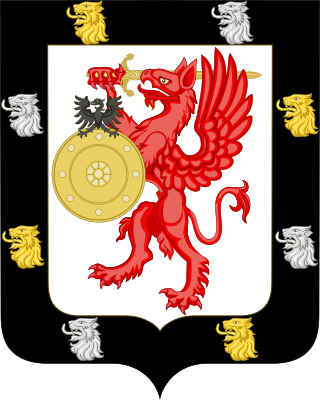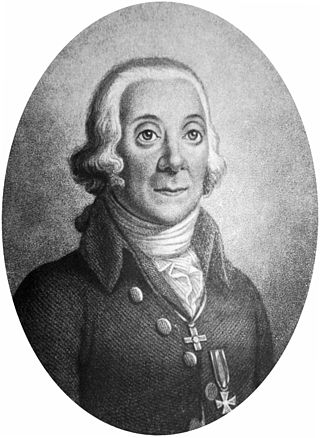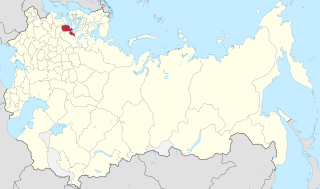
The House of Romanov was the reigning imperial house of Russia from 1613 to 1917. They achieved prominence after Anastasia Romanovna married Ivan the Terrible, the first crowned tsar of all Russia. Nicholas II and his immediate family were executed in 1918, but there are still living descendants.

Catherine IAlekseevna Mikhailova was the second wife and empress consort of Peter the Great, and empress regnant of Russia from 1725 until her death in 1727.

Peter I, commonly known as Peter the Great, was Tsar of all Russia from 1682, and the first Emperor of all Russia from 1721 until his death in 1725. He reigned jointly with his half-brother Ivan V until 1696. From this year, Peter was an absolute monarch who remained the ultimate authority. His methods were often harsh and autocratic.

The Russian Academy of Sciences consists of the national academy of Russia; a network of scientific research institutes from across the Russian Federation; and additional scientific and social units such as libraries, publishing units, and hospitals.

Peter Simon Pallas FRS FRSE was a Prussian zoologist, botanist, ethnographer, explorer, geographer, geologist, natural historian, and taxonomist. He studied natural sciences at various Universities in early modern Germany and worked primarily in the Russian Empire between 1767 and 1810.

Nikolay Mikhailovich Karamzin was a Russian historian, romantic writer, poet and critic. He is best remembered for his fundamental History of the Russian State, a 12-volume national history.

Saint Petersburg State University is a public research university in Saint Petersburg, Russia. Founded in 1724 by a decree of Peter the Great, the university from the beginning has had a focus on fundamental research in science, engineering and humanities.

The House of Yusupov is a Russian princely family descended from the monarchs of the Nogai Horde, renowned for their immense wealth, philanthropy and art collections in the 18th and 19th centuries. Most notably, Prince Felix Yusupov was famous for his involvement in the murder of Grigori Rasputin.

The Saint Petersburg Governorate was a governorate of the Russian Empire, with its administrative centre in Saint Petersburg. The governorate was composed of 44,613 square kilometres (17,225 sq mi) of area and 2,112,033 inhabitants. The Saint Petersburg Governorate was bordered by the Estonian and Livonian Governorates to the west, the Pskov Governorate to the south, the Novgorod Governorate to the east, the Olonets Governorate to the northeast, and the Vyborg Governorate of the Grand Duchy of Finland to the north. The governorate covered most of the areas of modern Leningrad Oblast and Ida-Viru, Jõgeva, Tartu, Põlva, and Võru counties of Estonia.

Grand Duchess Anna Petrovna of Russia was the eldest daughter of Emperor Peter I of Russia and his wife Empress Catherine I. Her younger sister, Empress Elizabeth, ruled between 1741 and 1762. While a potential heir in the reign of her nephew Peter II, she never acceded to the throne due to political reasons. However, her son Peter III became Emperor in 1762, succeeding Elizabeth. She was the Duchess Consort of Holstein-Gottorp by marriage. She was born in Moscow and died in Kiel in her youth, at the age of 20.

The Russo-Persian War of 1722–1723, known in Russian historiography as the Persian campaign of Peter the Great, was a war between the Russian Empire and Safavid Iran, triggered by the tsar's attempt to expand Russian influence in the Caspian and Caucasus regions and to prevent its rival, the Ottoman Empire, from territorial gains in the region at the expense of declining Safavid Iran.

The Twelve Collegia, or Twelve Colleges, is the largest edifice from the Petrine era remaining in Saint Petersburg. It was designed by Domenico Trezzini and Theodor Schwertfeger and built from 1722 to 1744.

The city of Saint Petersburg was founded by Tsar Peter the Great on 27 May 1703. It became the capital of the Russian Empire for more than two hundred years. Saint Petersburg ceased being the capital in 1918 after the Russian Revolution of 1917.

The Russian Empire, also known as Imperial Russia, was the final period of the Russian monarchy from its proclamation in November 1721, until its dissolution in September 1917. It consisted of most of northern Eurasia. The Empire succeeded the Tsardom of Russia following the Treaty of Nystad. The rise of the Russian Empire coincided with the decline of neighbouring rival powers: the Swedish Empire, the Polish–Lithuanian Commonwealth, Qajar Iran, the Ottoman Empire, and Qing China. It also held colonies in Russian America between 1799 and 1867. Covering an area of approximately 22,800,000 square kilometres (8,800,000 sq mi), it remains the third-largest empire in history, surpassed only by the British Empire and the Mongol Empire; it ruled over a population of 125.6 million people per the 1897 Russian census, the only census carried out during the entire imperial period. It featured great ethnic, linguistic, religious, and economic diversity.

Saint Petersburg, formerly known as Petrograd (1914–1924) and later Leningrad, is the second-largest city in Russia after Moscow. It is situated on the Neva River, at the head of the Gulf of Finland on the Baltic Sea. The city had a population of roughly 5.6 million residents as of 2021. Saint Petersburg is the fourth-most populous city in Europe, the most populous city on the Baltic Sea, and the world's northernmost city of more than 1 million residents. As Russia's Imperial capital, and a historically strategic port, it is governed as a federal city.

The Saint Petersburg Theological Academy is a higher education institution of the Russian Orthodox Church, located in Saint Petersburg, Russia. The academy preparing theologians, clergymen, singers and icon writers for the Eastern Orthodox Church and grants bachelor, master, candidate and doctorate degrees. It was founded in 1797 by Metropolitan Gabriel (Petrov) of Saint Petersburg, as part of the Alexander Nevsky Lavra.

The Botik of Peter the Great is a miniaturized scaled-down warship discovered by Peter the Great at the Royal Izmaylovo Estate in 1688. It was restored by Karshten Brandt, and Peter learned to sail using the boat on waters near Moscow. It was stored in the Kremlin of Moscow by Peter and later enshrined in St. Petersburg. Peter continued to use it in state ceremonies and ordered that the boat be sailed down the Neva River on 30 August of every year. It was used in state ceremonies of later Russian monarchs, including the wedding of Catherine the Great and Peter III of Russia, as well as the centennial celebration of St. Petersburg. Catherine built a boathouse in the 1760s to store it.

Carlo Bartolomeo Rastrelli was an Italian sculptor and architect. Born in Italy, he moved in 1716 to Russia, where he worked until his death. His most famous works include the Monument to Peter I and a wax figure and several busts of Peter the Great. His son Francesco Bartolomeo Rastrelli became a prominent architect in Russia.

Prince Alexei Borisovich Kurakin was a Russian statesman, Active Privy Councillor of the 1st class (1826), who held a number of top positions in the reign of Paul I and Alexander I. The direct ancestor of all subsequent Kurakin princes.




















